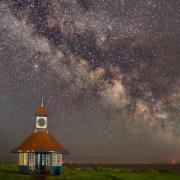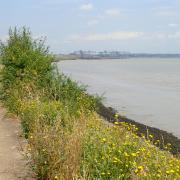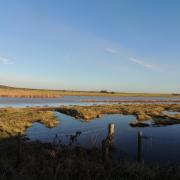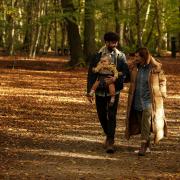Explore RSPB reserves across Essex for wildlife filled adventures this February
Imagine a walk where you breathe in the salty freshness of sea air while flocks of honking geese fly over your head, or a wildlife oasis surrounded by an urban jungle where a water vole swims speedily under the bridge you’re standing on. Essex is a county full of natural wonders, and you can find both of these experiences and more here. Take an outing to an RSPB reserve this month and discover what nature has to offer as winter begins to turn to spring.

RSPB Rainham Marshes
This wildlife hotspot in Purfleet is just a short distance from the city of London. Once a military firing range, RSPB Rainham Marshes forms part of the Thames Estuary, where you’ll find a wilderness of grazing marshland, reedbed and wetland habitats teeming with wildlife. The reedbeds here are home to a bird called a bearded tit. The male of this species has a striking black ‘moustache’ while the female has a more delicate brown coloured plumage. If you’re quiet, you can hear their ‘ping’ sounding calls drift over the reeds.
As you move by the waterways and ditches you may see the nationally rare water vole swimming or nibbling on vegetation by the bank. Rainham Marshes is home to 1% of the UK’s population. While out on the wetlands you could spot wildfowl like wigeon and teal, and wading birds like lapwing and redshank.
You can take a circular walk around the reserve, with a wheelchair accessible route available. However, if you fancy staying in the warm, visit the shop and café in the visitor centre that has great views across the reserve. Car parking is available, but the site is easily reached by public transport, with Purfleet station a short walk away.
RSPB Old Hall Marshes
Another coastal location in Essex which is just as exciting to explore is RSPB Old Hall Marshes near Maldon. Time your walk right and the estuary’s mudflats will be revealed from the water as the tide lowers, providing a can’t-miss buffet for birds like redshank and lapwing as the mud is teeming with prey. You might also spot the beautiful avocet, the symbol of the RSPB logo, with its striking black and white plumage and upcurved bill.
When you explore this reserve of extensive grazing marsh, you’ll also spot winter wildlife like wigeon, teal and dark-bellied brent geese grazing on the short grass. It’s worth keeping your eyes to the sky too for birds of prey, as the speedy peregrine falcon or marsh harrier may be on the hunt. The site has car parking and two walking routes to choose from. The shorter three-mile route follows natural grass pathways, while the longer six-mile circular walk, which involves steps, leads you along the sea wall.

RSPB Wallasea Island
If you’re after somewhere wild and exciting for a winter walk, then RSPB Wallasea Island is just the location for you. Situated along the River Crouch and Roach estuaries in Rochford, this 740-hectare site has undergone a magical transformation in recent years. As part of the Wallasea Island Wild Coast Project the reserve was restored to intertidal coastal marshland. Part of the reserve was created in 2015 using a technique called managed realignment, which is where the sea wall is breached, and the land is naturally flooded. The result here was the creation of a 165-hectare area called Jubilee Marsh. As part of this project, three million tonnes of soil, from the Crossrail scheme in London, was used to raise the land level. This allowed the rich mosaic of habitats to be created.
In the winter months the reserve is home to internationally significant numbers of wading birds like grey plover, knot and bar-tailed godwit. You can also experience a range of birds of prey such as hen harriers, short-eared owls and merlin, which use the grassland and marsh edges to hunt. Late afternoon is often a good time to see these species. As spring arrives wading birds like avocet and lapwing will begin to nest. Walking routes are varied here with six trails to choose from. A car park is located on site.
RSPB Canvey Reserves
Located on Canvey Island, RSPB West Canvey Marshes has habitats from reedbeds to saltmarsh, lagoons and grassland, that create a wild scene across the landscape. Look out onto the lagoons and wetlands when you explore the reserve, and you may see wading birds like redshank or wildfowl like teal. The male of this species has a chestnut head with a vivid green patch across its eye and head, while the female has a mottled brown colouration to its plumage. If you see a large white bird with a slender neck and long black legs and bill, then this is a little egret. They’re fun to watch as they will stir up the mud underwater with their feet in search of prey.
Around a mile away from this site is the reserve RSPB Canvey Wick, an ex-oil refinery. Home to rare plants and insects in the summer, winter brings large numbers of wildfowl and waders, like black-tailed godwit, that can be seen in the adjoining Holehaven Creek. The bee and orchid trails that can be explored here are around 0.9 miles long, with some great viewpoints. Car parking is available at both sites.
To discover an RSPB reserve near you for a winter walk, visit rspb.org.uk



























